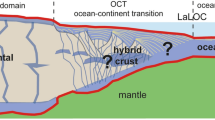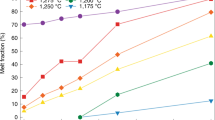Abstract
The distribution of continents is thought to influence the temperature of the underlying mantle. Over geological timescales, insulation effects generate a build-up of heat that may cause increased magmatism1,2,3,4, such as flood basalt volcanism5,6, and ultimately rift the continents, causing them to break apart and new ocean basins to form. Here we use analyses of the major element geochemistry of lava samples collected from oceanic crust in the Atlantic and Pacific oceans to quantify the effect of continental insulation. The lavas formed at mid-ocean ridges following continental rifting and break up, and preserve a record of upper mantle temperatures over the past 170 Myr. We find that samples from the Pacific Ocean—formed more than 2,000 km from the nearest continental margin—do not record raised mantle temperatures. In contrast, samples from the Atlantic Ocean that formed close to the margin of the rifted continent reveal an upper mantle temperature immediately after continental rifting that was up to 150 °C higher than the present-day average; mantle temperatures remained high for 60–70 Myr. We conclude that the Atlantic thermal anomaly was created by continental insulation, and persisted in the mantle beneath the Atlantic Ocean long after the continental fragments had dispersed.
This is a preview of subscription content, access via your institution
Access options
Subscribe to this journal
Receive 12 print issues and online access
$259.00 per year
only $21.58 per issue
Buy this article
- Purchase on Springer Link
- Instant access to full article PDF
Prices may be subject to local taxes which are calculated during checkout




Similar content being viewed by others
Change history
06 December 2016
In the version of this Letter originally published, the affiliations were not present in the online version. This has now been corrected.
References
Anderson, D. L. Hotspots, polar wander, Mesozoic convection and the geoid. Nature 297, 391–393 (1982).
Grigne, C. & Labrosse, S. Effects of continents on Earth cooling: Thermal blanketing and depletion in radioactive elements. Geophys. Res. Lett. 28, 2707–2710 (2001).
Lenardic, A., Moresi, L-N., Jellinek, A. M. & Manga, M. Continental insulation, mantle cooling, and the surface area of oceans and continents. Earth Planet. Sci. Lett. 234, 317–333 (2005).
Zhong, S. & Gurnis, M. Dynamic feedback between a continental-like raft and thermal convection. J. Geophys. Res. 98, 12219–12232 (1993).
Coltice, N., Phillips, B. R., Bertrand, H., Ricard, Y. & Rey, P. Global warming of the mantle at the origin of flood basalts over supercontinents. Geology 35, 391–394 (2007).
Coltice, N., Bertrand, H., Rey, P., Jourdan, F., Phillips, B. R. & Ricard, Y. Global warming of the mantle beneath continents back to the Archaean. Gondwana Res. 15, 254–266 (2009).
Gaffin, S. Ridge volume dependence on seafloor generation rate and inversion using long-term sealevel change. Am. J. Sci. 287, 596–611 (1987).
Berner, R. A. & Kothavala, Z. GEOCARB III: A revised model of atmospheric CO2 over Phanerozoic time. Am. J. Sci. 301, 182–204 (2001).
Hardie, L. A. Secular variation in seawater chemistry: An explanation for the coupled secular variation in the mineralogies of marine limestones and potash evaporites over the past 600 m.y. Geology 24, 279–283 (1996).
Marty, B. & Tolstikhin, I. N. CO2 fluxes from mid-ocean ridges, arcs and plumes. Chem. Geol. 145, 233–248 (1998).
Elderfield, H. & Schultz, A. Mid-ocean ridge hydrothermal fluxes and the chemical composition of the ocean. Annu. Rev. Earth. Planet. Sci. 24, 191–224 (1996).
Larson, R. L. Latest pulse of Earth: Evidence for a mid-Cretaceous superplume. Geology 19, 547–550 (1991).
Humler, E., Langmuir, C. H. & Daux, V. Depth versus age: New perspectives from the chemical compositions of ancient crust. Earth Planet. Sci. Lett. 173, 7–23 (1999).
Machetel, P. & Humler, E. High mantle temperature during Cretaceous avalanche. Earth Planet. Sci. Lett. 208, 125–133 (2003).
Klein, E. M. & Langmuir, C. H. Global correlations of ocean ridge basalt chemistry and axial depth and crustal thickness. J. Geophys. Res. 92, 8089–8115 (1987).
Niu, Y., Bideau, D., Hekinian, R. & Batiza, R. Mantle compositional control on the extent of mantle melting, crust production, gravity anomaly, ridge morphology, and ridge segmentation: A case study at the Mid-Atlantic Ridge 33–35° N. Earth Planet. Sci. Lett. 186, 383–399 (2001).
Regelous, M. et al. Variations in the geochemistry of magmatism on the East Pacific Rise at 10° 30′ N since 800 ka. Earth Planet. Sci. Lett. 168, 45–63 (1999).
Stein, C. A. & Stein, S. A model for the global variation in oceanic depth and heat flow with lithospheric age. Nature 359, 123–129 (1992).
Niu, Y. & O’Hara, M. J. Global correlations of ocean ridge basalt chemistry with axial depth: A new perspective. J. Petrol. 49, 633–664 (2008).
Waters, C. L., Sims, K. W., Perfit, M. R., Blichert-Toft, J. & Blusztajn, J. Perspective on the genesis of E-MORB from chemical and isotopic heterogeneity at 9–10° N East Pacific Rise. J. Petrol. 52, 565–602 (2011).
Janney, P. E. & Castillo, P. R. Geochemistry of the oldest Atlantic oceanic crust suggests mantle plume involvement in the early history of the central Atlantic Ocean. Earth Planet. Sci. Lett. 192, 291–302 (2001).
Janney, P. E. & Castillo, P. R. Geochemistry of Mesozoic Pacific mid-ocean ridge basalt: Constraints on melt generation and the evolution of the Pacific upper mantle. J. Geophys. Res. 102, 5207–5229 (1997).
Fisk, M. & Kelley, K. A. Probing the Pacific’s oldest MORB glass: Mantle chemistry and melting conditions during the birth of the Pacific Plate. Earth Planet. Sci. Lett. 202, 741–752 (2002).
Humler, E. & Besse, J. A correlation between mid-ocean-ridge basalt chemistry and distance to continents. Nature 419, 607–609 (2002).
Ligi, M. et al. Birth of an ocean in the Red Sea: Initial pangs. Geochem. Geophys. Geosys. 13, Q08009 (2012).
Kelley, K. A. et al. Mantle melting as a function of water content beneath back-arc basins. J. Geophys. Res. 111, B09208 (2006).
Herzberg, C. et al. Temperatures in ambient mantle and plumes: Constraints from basalts, picrites and komatiites. Geochem. Geophys. Geosyst. 8, Q02006 (2007).
Rolf, T., Coltice, N. & Tackley, P. J. Linking continental drift, plate tectonics and the thermal state of the Earth’s mantle. Earth Planet. Sci. Lett. 351–352, 134–146 (2012).
Whittaker, J. M., Müller, R. D., Roest, W. R., Wessel, P. & Smith, W. H. F. How supercontinents and superoceans affect seafloor roughness. Nature 456, 938–941 (2008).
Müller, R. D., Sdrolias, M., Gaina, C., Steinberger, B. & Heine, C. Long-term sea-level fluctuations driven by ocean basin dynamics. Science 319, 1357–1362 (2008).
Acknowledgements
This research used samples provided by the Integrated Ocean Drilling Program (IODP). Funding for this research was provided by the Deutsche Forschungsgemeinschaft (grants RE3020/1-1 and 1-2), and P.A.B. acknowledges a doctoral fellowship of the Erika Gierhl Foundation. We thank A. Richter, H. Brätz, C. Kaatz, N. Hohmann, F. Stöckhert, C. Weinzierl, F. S. Genske and the curators at Bremen and Gulf Coast Core Repositories for their help during sampling and data analysis, and the Smithsonian Institution for providing MORB glass standards.
Author information
Authors and Affiliations
Contributions
Sample collection, preparation and electron probe analyses carried out by P.A.B. All authors contributed to data interpretation and manuscript writing.
Corresponding authors
Ethics declarations
Competing interests
The authors declare no competing financial interests.
Supplementary information
Supplementary Information
Supplementary Information (PDF 6498 kb)
Rights and permissions
About this article
Cite this article
Brandl, P., Regelous, M., Beier, C. et al. High mantle temperatures following rifting caused by continental insulation. Nature Geosci 6, 391–394 (2013). https://doi.org/10.1038/ngeo1758
Received:
Accepted:
Published:
Issue Date:
DOI: https://doi.org/10.1038/ngeo1758
This article is cited by
-
Widespread diffuse venting and large microbial iron-mounds in the Red Sea
Communications Earth & Environment (2023)
-
Catastrophic slab loss in southwestern Pangea preserved in the mantle and igneous record
Nature Communications (2022)
-
A review of geoanalytical databases
Acta Geochimica (2019)
-
Decrease in oceanic crustal thickness since the breakup of Pangaea
Nature Geoscience (2017)
-
North Atlantic magmatism controlled by temperature, mantle composition and buoyancy
Nature Geoscience (2014)



